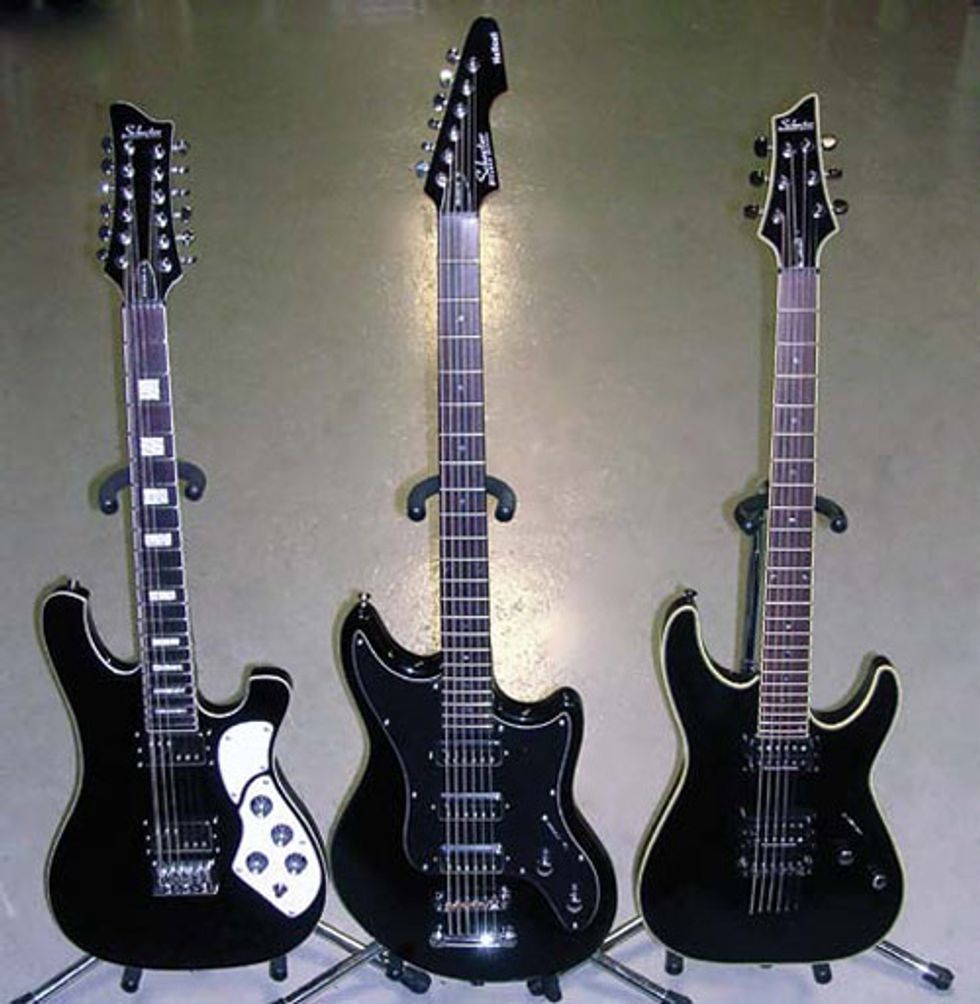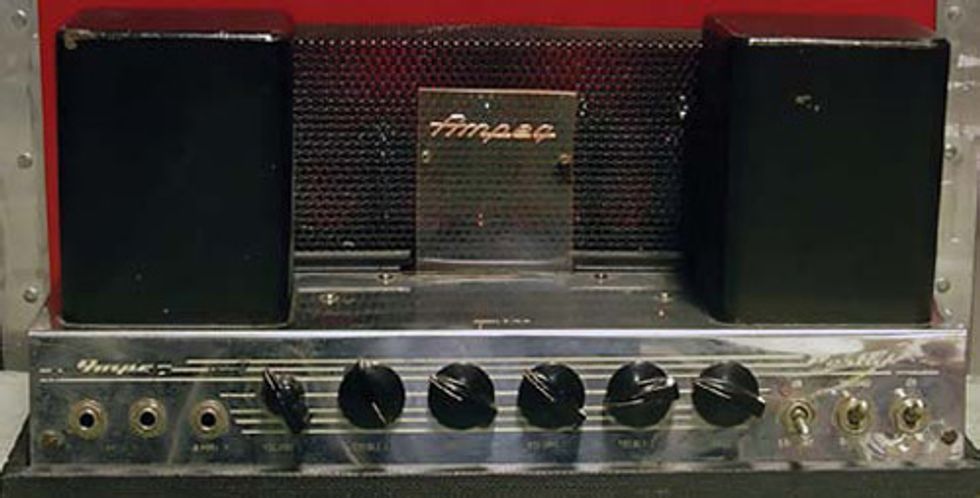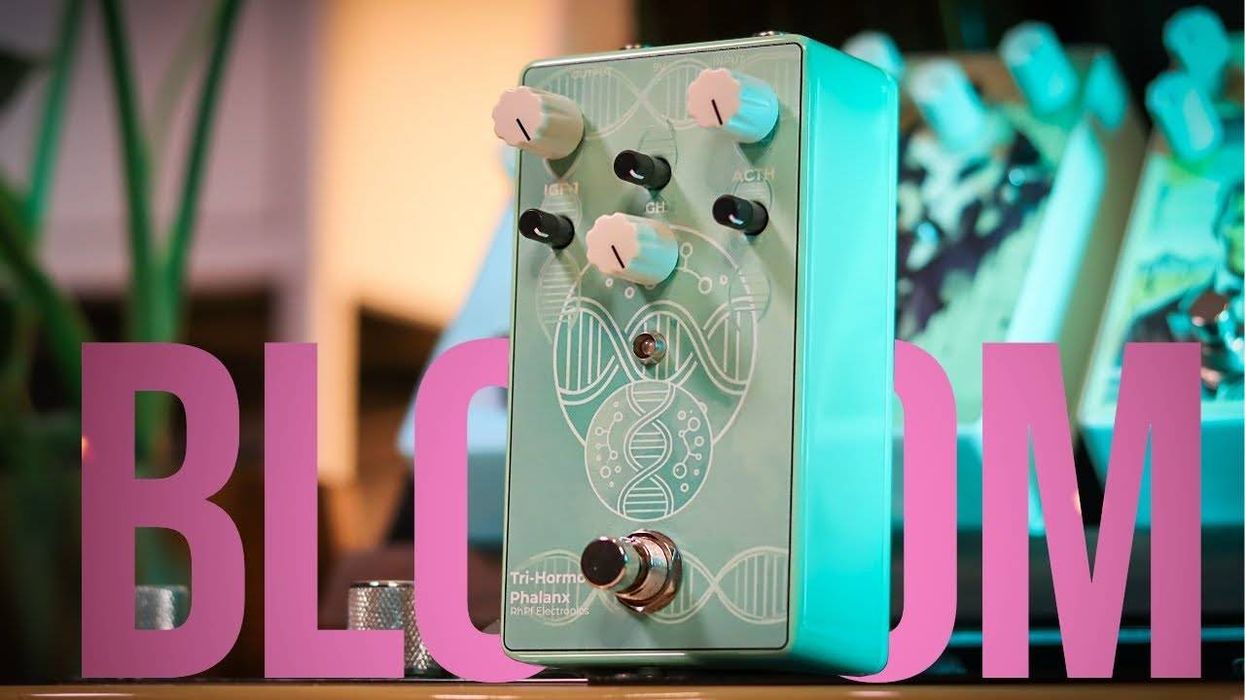

Top: A cosmic trio (left to right): Schecter Stargazer 12-String, Schecter Hellcat Vl,
Schecter Blackjack Baritone.
Bottom: A 1966 Ampeg B-15N bass amplifier works great for providing rich low end to baritone and 6-string basses, and also adds body to electric 12-string guitars, which can easily become too chimey and shrill.
Dialing in a guitar tone is a lot like cooking a meal: Every little ingredient or component alters the final product, and you have to make several crucial choices as you create a dish. Most of us have a pretty good idea of how to pull up a good guitar sound, but sculpting tones for specialty instruments—like baritone, 6-string bass, and electric 12-string—is a little more elusive. In this column, I’ll explain some different qualities I look for in specialty instruments, beginning with the 6-string bass.
A 6-string bass, like a Fender VI or Schecter Hellcat VI, offers a great way to add a thick layer of low-end reinforcement to a riff. Because a 6-string bass is tuned exactly one octave below a guitar, you don’t have to mentally transpose the fretboard. All the chord shapes, fingerings, and note names are identical to a standard guitar—they’re simply pitched an octave lower.
The Hellcat Vl has Duncan Designed MH-102 pickups, which do a great job of translating both attack and rich lows. A 6-string bass can easily become “woofy,” so I prefer low-tuned instruments with pickups that can be coil-tapped, like the MH-102s. Coil-tapping the pickup is a fast way to cut out unwanted bass frequencies.
Coil-tapping is also a great option on a baritone guitar, an instrument that’s typically tuned a fourth (B-B) or fifth (A-A) lower than the guitar. My Schecter Blackjack Baritone sports a pair of Seymour Duncan pickups, which deliver a nice variety of tones. The ’59 series pickup in the bridge position is huge sounding for high-octane rock, but when it’s coil-tapped I can also get tic-tac bass tones that work really well for old-time cowboy music.
Amps are another big factor in the specialty instrument tone equation. After experimenting with many guitar heads, bass heads, bass cabinets, and guitar cabinets, I’ve settled on a 1966 Ampeg B-15N bass head and a 2x12 Mesa/Boogie Lonestar cabinet for low-tuned specialty instruments.
What usually stops me from using a bass head for baritones and 6-string basses is that most bass amps are very high powered— which means they generally stay clean unless you push them to extreme levels. The B-15 was designed to be a bass amp, but it only puts out 15 watts, so it reacts very much like a guitar amplifier and breaks up quickly at low volumes. If you crank the volume and treble to 10 on a B-15, it produces an impressive classic-rock crunch without getting muddy, oversaturated, or too loud. Also, the B-15 is very accepting of pedals, which is good in case I need to add more overdrive.
Normally, I have the B-15’s treble set at 3 o’clock or completely dimed. This helps more of the guitar-like characteristics on a low-tuned instrument poke through the mix. B-15s from the mid ’60s had a speaker cable that was hardwired to the amplifier and terminated with an unusual, XLR-type plug. Obviously, this plug does not match the standardized 1/4" jacks on modern speaker cabinets, so my B-15 has been modified accordingly.
On the opposite end of the tonal spectrum, let’s look at 12-string guitar. Most guitarists, myself included, associate it with tuning nightmares. One of the main reasons I play a Schecter Stargazer 12 is because it has an adjustable bridge with locking mechanisms. This really helps in the tuning department, so I am free to deal with other aspects of the tone. Once again, the B-15 is my choice amp for this unique instrument, because it adds body to the 12-string’s sound. It’s easy for a 12-string to get too jangly and produce an offensive high end, so I use the B-15 to keep the upper register smooth and under control.
Going back to our cooking analogy: Creating an instrument tone is like making a stew. Frequencies are like flavors in that a single ingredient shouldn’t be too overpowering (too bitter or too bassy), because then it calls attention to itself and detracts from overall enjoyment of the dining or listening experience. Ingredients should work together to create a single pleasant taste—or tone. Over the years, I’ve found that most people’s ears are like their taste buds: They’re looking for quality that’s full and evenly distributed.
If the stage is your kitchen and your guitar rig is the cooking equipment, remember that it’s the chef that makes the meal taste great—not the stove used to boil the water. With that in mind, have fun in your sonic kitchen as you whip up some great treats for the world to enjoy!




![Rig Rundown: AFI [2025]](https://www.premierguitar.com/media-library/youtube.jpg?id=62064741&width=1245&height=700&quality=70&coordinates=0%2C0%2C0%2C0)












 Shop Scott's Rig
Shop Scott's Rig















































